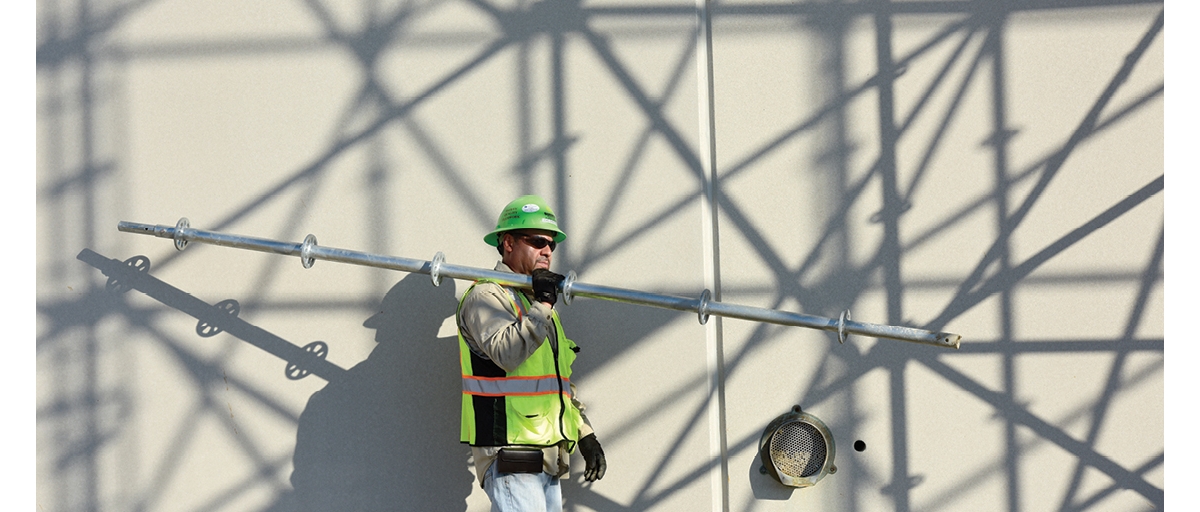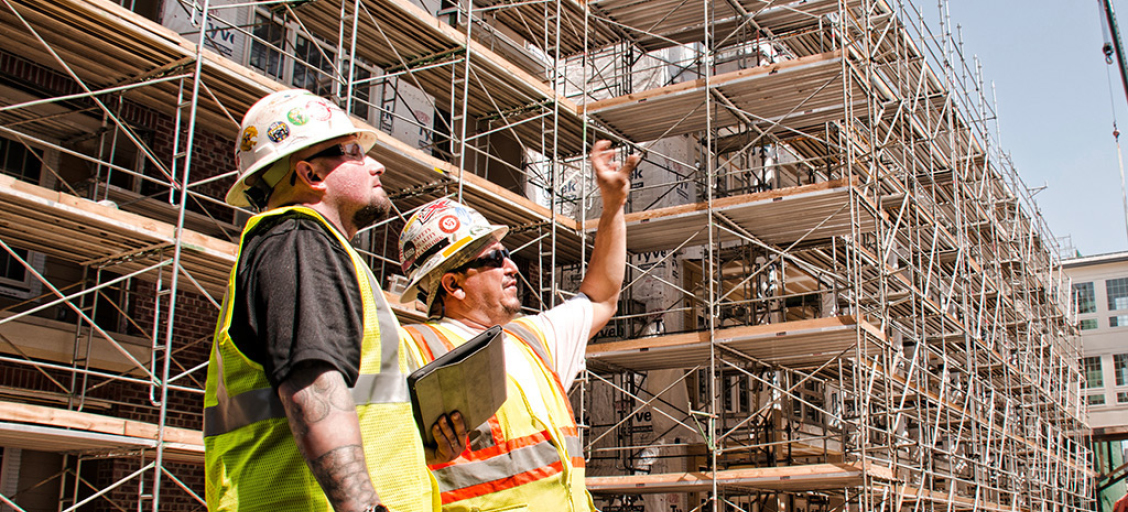Use the Sunbelt Rentals App
Find, rent, and return equipment, right at your fingertips

How to Choose the Right System Scaffold for Your Construction Project
System scaffolding offers many benefits for developing structures, with a simple construction that can quickly adapt to many projects.
Introduction to System Scaffolds
System scaffolds are among the most popular and well-established types of scaffolding worldwide. You’ll notice this modular scaffolding in many parts of the world, including Europe, Asia, Australia, and North and South America.
One of the key features of these system scaffolds’ formwork is how easy they are to transport, handle, assemble, and dismantle, all within a fraction of the time, compared to older, traditional scaffolding structures.
While there are different variations in scaffolding systems, they are all connected similarly, with various connection devices and fixed lengths secured with rosettes and connections to ensure a safe and secure structure.
Importance of System Scaffolds in Construction
Universal system scaffolding is adaptable to many developments, making them ideal in the construction industry. Each component offers a defined shape and size with connection points, so they can be built and disassembled faster than a tube or coupler scaffolding system.
System scaffolds save significant time, as once users are trained and plans are developed, they are more straightforward to set up, making them cost-effective. On large-scale construction projects, these scaffold systems can be assembled quickly and used quickly.
Types of System Scaffolds
Scaffolding systems are versatile, and you’ll find many variations, including, Ringlock or Pin-lock, Haki, Cuplock scaffolding, and Layher Allround. They all consist of similar components that are modular, which makes them easy and quick to assemble, which saves time and labor on construction sites.

Factors to Consider When Choosing System Scaffolds
When you are selecting the proper system scaffold structure for your construction project, there are several important factors to consider:
- Load capacity, or the ability to sustain heavy weight, is essential in choosing the right scaffold. Ringlock scaffolding is one of the most robust structures and consists of decking, scaffold stairs, guard rails, ledgers, adapters, free-span trusses, and ladders for greater access and support.
- What is the height of your project, and how much scaffolding will you need? It’s crucial to determine your project's accurate measurements to find the right type of system scaffolding and scaffold system layout for your structure.
- The easier it is to assemble your scaffolding system, the better! System scaffolding is an excellent option for this reason.
- How accessible is your scaffold structure? Is affixing a scaffold plank or ladder easy, or do you require scaffolding accessories to improve access?
- Universal system scaffolding varies in price, though modern system scaffolds are the most cost-effective, especially for large-scale construction projects.
- You’ll need to consider the level of safety and any additions you’ll need, such as stair towers for safe access to work platforms, with no protruding tubes or items that pose a risk of injury or damage.
- System scaffolds are one of the most stable erection options for construction sites, increasing their safety.
Load Capacity
How much equipment, supplies, and personnel must the various scaffolds accommodate throughout a construction project? Understanding the approximate weight of everything is an important factor; you’ll need to calculate the load capacity of what is needed which is essential.
At the same time, steel scaffolding is sturdy, with various light medium, and heavy-duty scaffolds that offer various load capacities.
For example, light-duty scaffolding typically supports 25 lbs for every square foot, medium-duty supports up to 50 lbs, and heavy-duty scaffolds can handle up to 75 lbs per square foot.
Height Requirements
System scaffolds are labeled with their dimensions, so you can determine which fitting scaffolding is best for your access project. This essential feature gives you the correct spacing you’ll need for personnel and equipment and reduces the risk of accidents.
You’ll need to find the exact measurements of your building and any height restrictions or obstacles that can impact the ability to transport equipment, tools, and personnel to complete the job. Fortunately, many systems scaffolds are flexible, so you can adapt to fit a slight change in height or reach if needed.
Accessibility and Ease of Assembly
When you choose system scaffolding, you’ll find it’s straightforward to assemble, which gives you total flexibility to set up quickly and take down when needed. It’s highly adaptable, so you can set up scaffolding systems to easily access all areas of a building or structure.
Budget
When you are considering investing in system scaffolding, the price, shipping, accessories, and the challenges of accommodating storage space can vary. It’s essential to stay within your budget, and renting equipment, including scaffolding systems, can provide a cost-effective solution for all your construction needs.
In addition, it’s important to determine the type of scaffolding you’ll need and whether system scaffolding is the best solution for your project or if suspended scaffolding or a similar structure works best for a site with unstable ground or unique developments that require specific accessories.
Safety and Stability
One of the most important considerations when building a scaffold is safety. When you work directly with Sunbelt Rentals Scaffold Services, you’ll have access to the top scaffolding systems that meet safety standards and regulations and are recommended by professionals with years of scaffolding experience.
It’s crucial to ensure all personnel and contractors are adequately trained on accessing scaffold and that any other structures, such as a suspended scaffold, a brace, screw jack, post shore, and other equipment, is installed safely and securely.
Whether you’re welding, building, or installing several items on the exterior or interior of a building, such as a transom or a windowpane, it’s important to keep the scaffold secure and accessible with stable guardrails, slip-resistant platforms, handrails, and other safety features to prevent injury.
Conclusion
Sunbelt Rentals Scaffold Services offers a wide range of system scaffolding, aerial work platforms, and related rental equipment for your construction project. Our team of rental experts can provide you with design, installation, and rental quotes to accommodate any development.
Frequently Asked Questions
Question: What is a system scaffold?
Answer: System scaffolding is a modular network of components engineered for easy assembly, including supporting transoms and joints to provide stable, safe access to working platforms.
Question: How does the height of a system scaffold affect its stability?
Answer: System scaffolding must adhere to the maximum height standards to maintain stability, along with the proper safety equipment, such as guardrails, handrails, non-slip surfaces, and structural support.
Question: How does the load capacity of a system scaffold affect its safety?
Answer: It’s essential to determine the weight of tools, equipment, materials, and the number of personnel required. Light or moderate-duty scaffolding systems are best for projects with minimal or lightweight tools and equipment, and heavy-duty scaffolding is required for heavier items to ensure safety. When the wrong scaffolding system is chosen for a project, this can impact the safety of personnel and the stability of equipment and tools on each operating platform.
Question: What are the most common types of system scaffolds?
Answer: The most common types of system scaffolding include Cuplock, and Ringlock.
Question: How much does a system scaffold typically cost?
Answer: The cost of scaffolding depends on several factors, including the total weight capacity, the number of scaffold pieces or components, and the accessories required to support the structure. Other costs include design and engineering, assembling, and disassembling the system scaffolding, and changes to the setup, as required.
